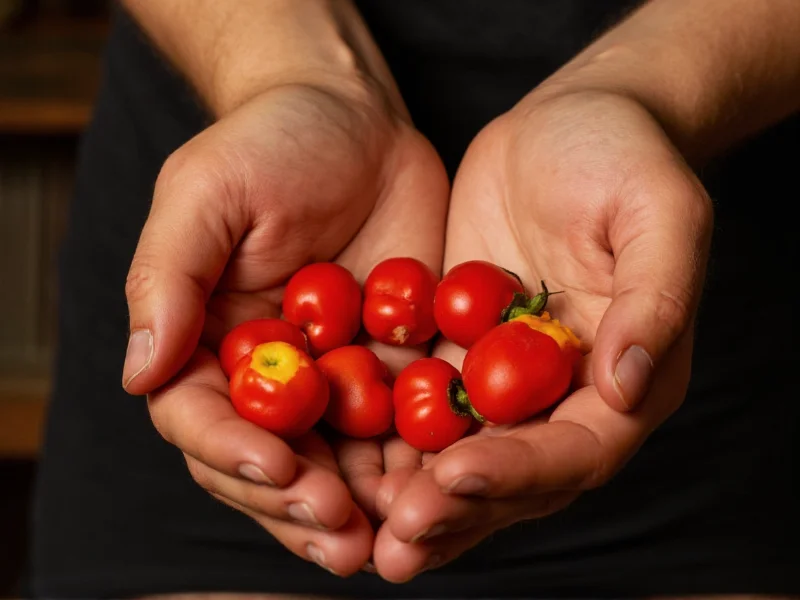If you're experiencing burning from peppers on your hands, immediately wash with cold water and soap, then apply a dairy product like milk or yogurt, or vegetable oil. These substances dissolve capsaicin—the oil in peppers causing the burn—providing fast relief. Avoid hot water, which opens pores and worsens the sensation.
Why Pepper Burn Happens: The Science Behind the Sting
When you handle hot peppers, you're encountering capsaicin—the active compound responsible for their heat. Capsaicin is an oil-based molecule that binds to TRPV1 receptors in your skin, which normally detect heat and pain. This triggers a burning sensation similar to actual heat exposure, even though no physical damage has occurred.
Unlike water-soluble irritants, capsaicin is oil-based, which explains why washing with water alone provides minimal relief. The compound can remain on your skin for hours or even days if not properly removed, causing persistent discomfort and potentially transferring to other sensitive areas like your eyes.
Effective Remedies for Pepper Burn Relief
Understanding capsaicin's oil-based nature is key to finding effective relief. Here are scientifically-backed methods to eliminate pepper burn from hands:
Dairy-Based Solutions
Milk, yogurt, or sour cream contain casein, a protein that breaks down capsaicin molecules. Apply full-fat dairy products directly to affected areas and massage gently for 2-3 minutes before rinsing. The fat content enhances capsaicin dissolution, providing faster relief than skim dairy products.
Oil-Based Treatments
Vegetable oil, olive oil, or even rubbing alcohol work through the "like dissolves like" principle. Apply a small amount to a cotton ball and gently wipe affected areas. Follow with soap and water to remove the oil mixture. This method is particularly effective for severe pepper burns on hands that haven't responded to other treatments.
| Remedy | Effectiveness | Time to Relief | Notes |
|---|---|---|---|
| Dairy products | ★★★★☆ | 2-5 minutes | Full-fat works best; reapply if needed |
| Vegetable oil | ★★★★☆ | 3-7 minutes | Follow with soap wash |
| Rubbing alcohol | ★★★☆☆ | 5-10 minutes | May cause temporary stinging |
| Lemon juice | ★★☆☆☆ | 10-15 minutes | Less effective; may irritate skin |
| Water alone | ★☆☆☆☆ | Minimal relief | Worsens with hot water |
What Doesn't Work (Common Myths)
Despite popular belief, certain remedies actually worsen pepper burns. Hot water increases blood flow and opens pores, allowing more capsaicin absorption. Vinegar provides minimal relief as capsaicin isn't pH-sensitive. Baking soda pastes may irritate skin without effectively neutralizing the compound.
Preventing Pepper Burns During Food Preparation
Prevention is always better than treatment when dealing with capsaicin exposure. Professional chefs and home cooks who regularly handle hot peppers employ these proven prevention strategies:
- Wear nitrile gloves (latex offers poor protection against oils)
- Prepare peppers on a dedicated cutting board that won't transfer oils to other foods
- Wash hands thoroughly with soap immediately after handling, even if wearing gloves
- Keep dairy products nearby during preparation for quick response to accidental exposure
- Avoid touching your face while working with hot peppers
For those with sensitive skin or working with extremely hot varieties like ghost peppers or Carolina reapers, consider using specialized pepper-handling tools that minimize direct contact.
When to Seek Medical Attention for Pepper Burns
While most pepper burns resolve with home treatment, certain symptoms indicate the need for professional medical care:
- Persistent burning lasting more than 24 hours despite proper treatment
- Visible skin irritation, blistering, or chemical burns
- Burning sensation that spreads to other body areas
- Accidental transfer to eyes or mucous membranes
- Signs of allergic reaction (hives, swelling, difficulty breathing)
For eye exposure, immediately flush with cool water for 15 minutes and seek medical attention. Do not rub eyes, as this spreads the capsaicin and increases discomfort.
Understanding Capsaicin Persistence and Transfer
Many people don't realize that capsaicin can remain active on surfaces for weeks. This explains why you might experience unexpected burning days after handling peppers. The compound transfers easily to other surfaces including:
- Door handles and light switches
- Electronic devices
- Towels and clothing
- Other food preparation tools
Thoroughly clean all surfaces that came into contact with peppers using soap and water or appropriate cleaning solutions to prevent accidental re-exposure. This is particularly important when treating pepper burn on hands that keeps returning despite initial relief.
Special Considerations for Different Pepper Varieties
Not all peppers create the same intensity of burn. The Scoville scale measures capsaicin concentration:
- Mild peppers (bell peppers, poblanos): 0-1,000 Scoville units - rarely cause significant burns
- Medium heat (jalapeños, serranos): 2,500-23,000 Scoville units - moderate burning requiring treatment
- Hot peppers (habaneros, Thai chilis): 100,000-350,000 Scoville units - intense burns needing immediate attention
- Extreme heat (ghost peppers, Carolina reapers): 855,000-2,200,000 Scoville units - severe burns requiring careful treatment
The higher the Scoville rating, the more persistent the burn and the more aggressive your treatment approach should be. For extremely hot varieties, consider using multiple treatment methods simultaneously for faster relief from severe pepper burns on hands.
Long-Term Management of Pepper Sensitivity
Some individuals develop increased sensitivity to capsaicin through repeated exposure. If you regularly work with hot peppers, consider these long-term strategies:
- Build tolerance gradually by handling milder peppers first
- Use barrier creams containing dimethicone before handling peppers
- Keep emergency treatment supplies readily accessible
- Rotate pepper-handling duties if working in a team environment
Interestingly, repeated controlled exposure can sometimes desensitize TRPV1 receptors, reducing future burning sensations—a phenomenon professional chili handlers often experience.











 浙公网安备
33010002000092号
浙公网安备
33010002000092号 浙B2-20120091-4
浙B2-20120091-4